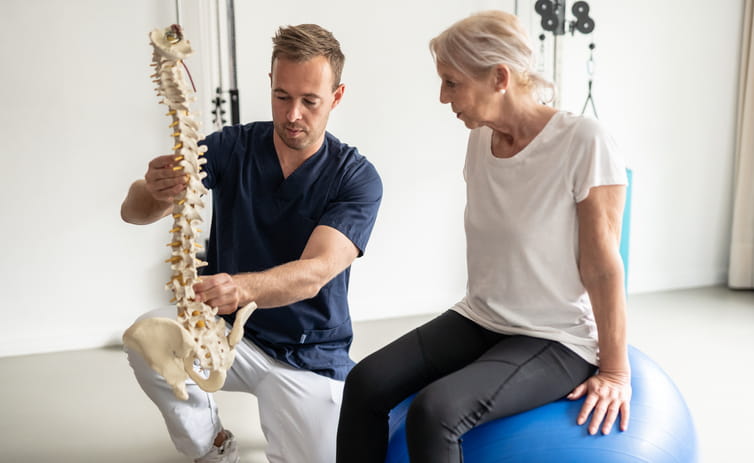When to See a Primary Care or Urgent Care Provider

When home treatment isn’t enough, it may be time to seek medical care. You should see your primary care provider, visit an urgent care or schedule an appointment with our Access Clinic if:
- Your pain has not improved at all after a reasonable attempt of home treatments
- You treat at home and see some improvement, but you still have significant pain after six weeks
- You have worsening neurological changes associated with the onset of the pain such as weakness
- You have a history of cancer
- You are developing fevers in association with your back pain
- You live with chronic lower back pain (In this case, your provider should rule out other problems)
When to Seek Immediate Medical Attention

There are some situations in which back pain is caused by a serious condition. If you are experiencing any of the following symptoms, you should call 911 or go to the emergency room.
- Any suspected spinal cord injury
- Pain with unexplained weight loss
- Intense back pain with any of the following:
- Inability to stand or walk
- Inability to elevate foot off the ground
- New onset loss of bladder and bowel control
- Numbness in the pelvis, groin, thighs or buttocks
- Sudden numbness in one or both legs
- High fever (over 101.0 F)
- Intense pain not controlled by over-the-counter medications
- Inability to stand or walk
Potential Causes of Back and Neck Pain
Pain related to the spine, especially in the neck or lower back, is common. Most adults experience neck or back discomfort at some time, though the causes can vary. Some of the most frequent causes include:
Strains
A muscle or ligament strain can cause discomfort, tenderness and a limited range of motion.
Disc problems
Degenerated, bulging or herniated discs can press on nerves and cause pain.
Arthritis
Arthritis can affect the facet joints in the spine, leading to morning stiffness and pain.
Improper Posture
Slouching, hunching or sticking your neck out to look at a phone can all strain your back and neck muscles, causing pain from muscle fatigue.
Improper Lifting
Lifting by bending at the waist instead of with your knees can cause back strain.
Injuries & Accidents
Accidents, falls or sports injuries can damage the spine and cause back pain.
Other medical conditions
Issues like kidney stones, infections or endometriosis can sometimes cause back pain.
Back pain with high fevers or long-term chronic back pain should be evaluated by a health care provider.
If you have strained your back or live with chronic back pain, you can try these home remedies:
- Alternating heat and ice
- Over-the-counter non-steroidal anti-inflammatory drugs (NSAIDs), such as Advil or Aleve
- Rest (but it is essential to maintain some movement.)
- Gentle stretching
- Walking
- Massage
Most back strains will take time to heal. Medications that reduce inflammation can help with recovery. While some people are back to normal after a few days, others may not return to normal for weeks.
While recovering, it is important to maintain as much regular movement as possible to keep your core muscles strong and flexible. But be careful not to aggravate the injury. Avoid movements that could re-injure your back, such as bending at the waist to lift, twisting the body or sitting with poor posture.

Do’s and Don’ts for Back, Neck and Spine Pain
Do
While it is tempting to lie down in bed or rest in a recliner until you feel better, this is not always the best treatment. Lack of movement can actually make you stiff, achy and even decondition your back muscles. It is better to try stay mobile with walking and gentle stretching. When recovering from a back strain one should not start high-impact exercises, sit-ups or weightlifting, as you don’t want to aggravate the injury, but maintaining some level of activity is very helpful in the long run.
Listen to Your Body
Your body lets you know what movements make things worse. If you have to sit for long periods of time for your job, be sure to maintain your posture and take regular breaks to stretch, stay limber and move around. If you spend long stretches of time in the car, consider a pillow to support your lower back and help you sit up straight with something to support the arch of the lumbar spine. Stay as active as you can, but listen to your body when you need to take a break, use ice or heat or take a non-steroidal anti-inflammatory medication like Tylenol (acetaminophen), Advil (ibuprofen) or Aleve (Naproxen).
Help Your Body Heal
Eating right, drinking enough water and getting enough sleep are all important ingredients in a healthy recovery. You can give your body the right fuel to repair damaged tissue by focusing on fruits and vegetables, lean proteins, whole grains and healthy fats, while making sure to stay hydrated. Avoiding processed food that are high in sugar helps with healing. Make a good night’s sleep a top priority. A lot of healing occurs while we sleep. The quality of one’s sleep is more important than the type of mattress one sleeps on or the position of a person when sleeping.
Don't
Many back strains take eight weeks to heal. Although it would be nice, there isn’t a magic wand that can speed up that timeline. Instead of being discouraged, try to focus on what you can control each day: maintaining a positive attitude, staying active, getting enough rest, eating right and drinking water.
Don’t Make it Worse
After putting in the time and effort to recover, the last thing you want to do is re-injure yourself or make the pain worse. Certain motions are more likely to aggravate the problem. It’s best to avoid movements that involve sudden bending and twisting, such as quickly turning to pick up a child, or bending at the hips to lift something instead of bending at the knees.
Don’t Ignore Serious Symptoms
While most back pain heals on its own, there are times when you shouldn’t wait to seek medical care. Review the information below to learn what symptoms require emergency care.

Relief is a Non-Linear Journey
When it comes to spine issues, the path to recovery isn’t always straightforward. With such a wide range of different causes, the diagnosis process may involve multiple steps, and because every situation is different, you may need to try more than one type of treatment before finding what works best for you. Even after recovering from a back or neck injury, reinjury can sometimes occur, and those with chronic conditions may need to periodically reevaluate their treatment plans. Through it all, our comprehensive spine care team will be at your side to manage every aspect of the process, simplifying a potentially complex journey and guiding you to recovery.
